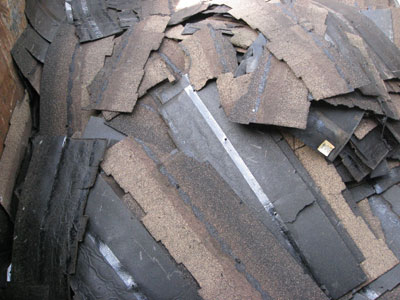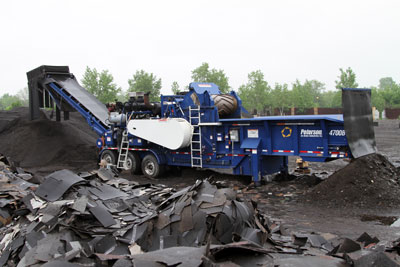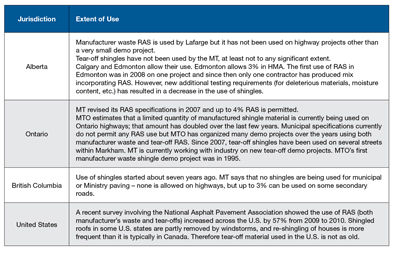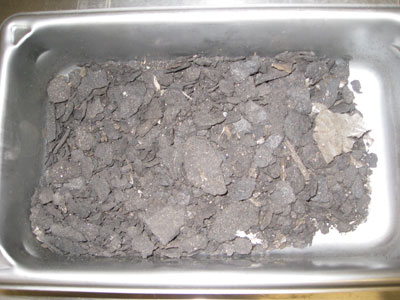
Features
Roads & Paving
Technology
State of RAP Industry II From roof to road
A look at the use of shingles in asphalt recycling.
August 10, 2012 By Treena Hein
Like the use of recycled asphalt, use of recycled asphalt shingles (RAS) in paving makes a great deal of sense.
Like the use of recycled asphalt, use of recycled asphalt shingles (RAS) in paving makes a great deal of sense. Done right, reuse of any material saves money and reduces environmental impact. Shingles are typically composed of 25 to 30% asphalt cement, 40 to 60% hard aggregate and 3 to 12% fibres, all of which are needed in hot-mix asphalt (HMA) production.

|
|
Several factors come into play with the use of RAS – the availability of supply, processing issues and how much is allowed by local jurisdictions in asphalt mixes (see chart for extent of use in Canada and the United States). There are two RAS supply streams – manufacturer waste shingle material, which requires a minimum of processing, and tear-off shingles from buildings (also called post-consumer shingle material). The latter is in much greater supply. Every year in Canada, tear-off shingles amount to 1.5 million tonnes, according to Dr. Susan Tighe, the Canada Research Chair in Pavement and Infrastructure Management and the director of the Centre for Pavement and Transportation Technology (CPATT) at the University of Waterloo, in Waterloo, Ont.
Concerns with tear-off shingles
“Tear-off shingles present many additional challenges (compared to manufacturer waste shingle material), with potential contamination with wood and nails along with highly oxidized asphalt,” notes Chuck McMillan, director of surface engineering and aggregates at the Alberta Ministry of Transportation. After large debris removal, tear-off RAS material is ground up (milled) to reduce particle size and then passed through a magnetic sorter to remove nails and staples. This is followed by a final grinding down to the desired size.
 |
|
| The Peterson 4700B grinds a pile of asphalt shingles into recycled asphalt to use in road construction.
|
Moisture in recycled materials is always a concern, and shingles are no exception, notes Sandy Brown, technical director at the Ontario Hot Mix Producers Association (OHMPA). “Mould grows on old [moist] shingles, which could cause a health and safety concern,” says Seyed Tabib, a senior bituminous engineer with the Ministry of Transportation in Ontario (MTO). Any RAS-using paving contractors for the City of Edmonton, notes the city’s construction services engineer, Hugh Donovan, must have their RAS piles covered to prevent moisture addition.
The moisture itself also adds to processing costs. “In HMA or Warm Mix Asphalt (WMA), the aggregates must be dry, and it takes heat to first convert the water to vapour to get rid of it and then to heat the aggregate,” Brown explains. “The less water, the less fuel you burn.” He says it’s not possible to directly heat recycled asphalt pavement (RAP) or RAS as that would tend to burn the asphalt cement (AC). “As a result, these materials are added at environmental temperatures to hot aggregates and mixed dry before the addition of the virgin AC,” Brown says. “The higher the moisture content of the RAP or RAS, the more the mix cools after the addition of the recycled material. This usually means that you have to run the plant at a higher temperature and burn more fuel, and that costs more.”
In addition to debris and moisture, there are other possible issues lurking in tear-off material. Shingles contain fibres and in the past, those fibres may have been asbestos, Brown notes. However, he says, “Asbestos in asphalt is not as much of a concern as you might think because the AC and the asbestos are very tightly bound together in shingles, and even crushing operations don’t tend to result in airborne asbestos.” Derek Izworski, sales manager at Astec’s Peterson Pacific Corporation, notes that asbestos studies of RAS-containing asphalt have been done in many U.S. states and come back negative.
A compound called Polycyclic Aromatic Hydrocarbons (PAH) is also found within all shingles. “PAH emissions are a concern during HMA production and leaching of PAH when exposed to environmental conditions such as rain, snow and freeze/thaw cycles on the road,” says Tabib. “The effect of PAH on pavement performance is unknown and further study on the exposure aspects . . . is required.”
Tabib also points to the fact that composition of tear-off shingle material can vary, as it comes from multiple manufacturers and has undergone varying degrees of weathering and aging. This is a major concern, says Donovan in Edmonton. “We do not want to add something to our hot mix that will give us a poorer performing product,” he notes.
The performance of RAS-containing asphalt relates strongly to how much of the AC is actually usable from the shingle. “Testing indicates AC contents range from 30 to 35% of the RAS component, but how much is really being released into the hot mix?” Donovan asks. “Our specifications require that mixes which contain RAS have a minimum virgin binder content of 80% in surface course mixes and 75% in base course mixes. We also require rheological testing of the virgin binder and the blended binder to ensure that our PG 58-28 requirement is not being adversely affected.”

|
|
Studying RAS-containing mixes
Dr. Tighe and her colleagues are doing ongoing studies on the effect of using RAS in HMA in collaboration with Miller Paving Limited and the Ontario Centres of Excellence. The team has evaluated the use of clean tear-off material in six typical Ontario HMA mixtures in the lab and field (four years on the three residential streets in Markham and two years at the CPATT Test Track) in comparison to conventional HMA.

|
|
The mixes were HL 3 (1.5% RAS, 13.5% RAP), binder layer mixes SP19E (6% RAS, and 3% RAS, 25% RAP), surface layer mixes SP12.5 FC 1 (3% RAS, 17% RAP) and SP12.5 FC2 (6% RAS, and 3% RAS, 12% RAP).
The team did a life-cycle assessment to quantify the environmental impacts as well as a rigorous economic costs/benefits analysis. Test cylindrical slabs were also created and exposed to freeze-thaw cycles based on weather data over the past 10 years.
“Our results demonstrated that the pavements were in good condition throughout the study period,” says Tighe. “We found encouraging results for the use of RAS in HMA pavements, from which guidelines can be developed for low to medium-volume roads.” The binder layer mix with 3% RAS, 25% RAP exhibited the best overall performance with exceptionally high frictional-resistance (safety) properties. The life-cycle assessment results showed that this mix was also the most cost-effective HMA mix, with the least environmental effect in terms of emissions, energy usage and water consumption.
Brown notes that in Ontario, RAS is only currently allowed to replace RAP at a ratio of 10:1. “This is because roofing-grade asphalt used in shingles is different that paving-grade asphalt,” he explains. With roofing grade asphalt, air is blown through the AC at higher temperatures when it is more liquid. “The air oxidizes the AC, making it harder,” Brown notes.
“The same process happens to paving grade asphalt on a roadway, but to oxidize it to the same degree could take 40 to 50 years.” Brown says the MTO has decided that asphalt from new shingles is about 10 times stiffer than asphalt from RAP, but that this is likely overly conservative.
“While the stiffer AC can improve rut resistance, it makes the material more susceptible to cracking,” notes Senior MTO Bituminous Engineer Pamela Marks. In 2011, the MTO reviewed many of the RAS demo projects that it has organized in the past (more are planned), and Marks says, “Overall, the performance of the pavements has been slightly below conventional pavements.” Lafarge has also done many studies over the past 20 years on RAS use.
Incorporating ground-up RAS
Brown at OHMPA says RAS is usually blended with RAP first to get better dispersion in the mix. Marks notes that shingle processors use a variety of methods to prevent clumping and to ensure uniform distribution of RAS particles.
According to Izworski, the sizing of ground-up shingles has decreased over time. “In previous years, a 5/8” size and smaller was needed, but now most contractors need 100% passing 3/8” minus,” he observes. “The reason to grind smaller is because in testing the larger product, it was found that there was still unused AC content available to recover. By going to a 3/8” minus, the maximum benefit of AC content is recovered and the paving companies save money.”
“Some people air-separate the grit (aggregate granules on the shingles) from the flake (asphalt, AC, backing and fibres) to get better use of the material,” Brown notes. “The granules used for shingles are of very high quality because they have to last in an exposed condition for a long time. The crushing process typically doesn’t leave much AC on the grit. This part of the material can be used in any mix.”
In Brown’s view, if the incorporation of a waste stream like tear-off shingles reduces the lifetime of a pavement – or worse, makes the material unrecyclable in the future – it’s a disservice to both the industry and the public. “HMA producers are very aware of this, and consequently are very concerned about adding new materials until the effects can be evaluated,” he says. “The current policy for RAS is working. We have to study RAS-containing pavements a bit more, which makes Dr. Tighe’s work and the continuing MTO demo studies so important.”
Print this page